Jan Mendling
Sustainability via LLM Right-sizing
Apr 17, 2025Abstract:Large language models (LLMs) have become increasingly embedded in organizational workflows. This has raised concerns over their energy consumption, financial costs, and data sovereignty. While performance benchmarks often celebrate cutting-edge models, real-world deployment decisions require a broader perspective: when is a smaller, locally deployable model "good enough"? This study offers an empirical answer by evaluating eleven proprietary and open-weight LLMs across ten everyday occupational tasks, including summarizing texts, generating schedules, and drafting emails and proposals. Using a dual-LLM-based evaluation framework, we automated task execution and standardized evaluation across ten criteria related to output quality, factual accuracy, and ethical responsibility. Results show that GPT-4o delivers consistently superior performance but at a significantly higher cost and environmental footprint. Notably, smaller models like Gemma-3 and Phi-4 achieved strong and reliable results on most tasks, suggesting their viability in contexts requiring cost-efficiency, local deployment, or privacy. A cluster analysis revealed three model groups -- premium all-rounders, competent generalists, and limited but safe performers -- highlighting trade-offs between quality, control, and sustainability. Significantly, task type influenced model effectiveness: conceptual tasks challenged most models, while aggregation and transformation tasks yielded better performances. We argue for a shift from performance-maximizing benchmarks to task- and context-aware sufficiency assessments that better reflect organizational priorities. Our approach contributes a scalable method to evaluate AI models through a sustainability lens and offers actionable guidance for responsible LLM deployment in practice.
Unraveling the Never-Ending Story of Lifecycles and Vitalizing Processes
Jul 25, 2024


Abstract:Business process management (BPM) has been widely used to discover, model, analyze, and optimize organizational processes. BPM looks at these processes with analysis techniques that assume a clearly defined start and end. However, not all processes adhere to this logic, with the consequence that their behavior cannot be appropriately captured by BPM analysis techniques. This paper addresses this research problem at a conceptual level. More specifically, we introduce the notion of vitalizing business processes that target the lifecycle process of one or more entities. We show the existence of lifecycle processes in many industries and that their appropriate conceptualizations pave the way for the definition of suitable modeling and analysis techniques. This paper provides a set of requirements for their analysis, and a conceptualization of lifecycle and vitalizing processes.
Timeline-based Process Discovery
Dec 21, 2023Abstract:A key concern of automatic process discovery is to provide insights into performance aspects of business processes. Waiting times are of particular importance in this context. For that reason, it is surprising that current techniques for automatic process discovery generate directly-follows graphs and comparable process models, but often miss the opportunity to explicitly represent the time axis. In this paper, we present an approach for automatically constructing process models that explicitly align with a time axis. We exemplify our approach for directly-follows graphs. Our evaluation using two BPIC datasets and a proprietary dataset highlight the benefits of this representation in comparison to standard layout techniques.
Knowledge-Driven Modulation of Neural Networks with Attention Mechanism for Next Activity Prediction
Dec 14, 2023
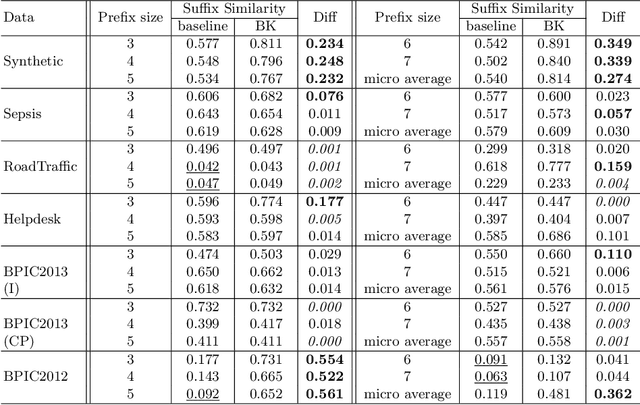
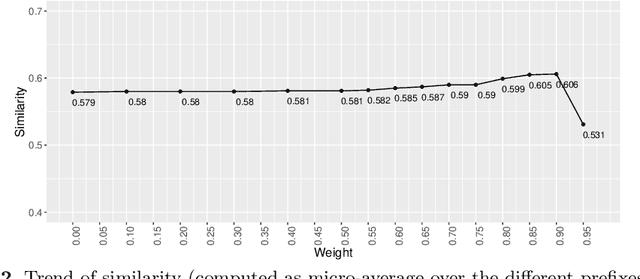
Abstract:Predictive Process Monitoring (PPM) aims at leveraging historic process execution data to predict how ongoing executions will continue up to their completion. In recent years, PPM techniques for the prediction of the next activities have matured significantly, mainly thanks to the use of Neural Networks (NNs) as a predictor. While their performance is difficult to beat in the general case, there are specific situations where background process knowledge can be helpful. Such knowledge can be leveraged for improving the quality of predictions for exceptional process executions or when the process changes due to a concept drift. In this paper, we present a Symbolic[Neuro] system that leverages background knowledge expressed in terms of a procedural process model to offset the under-sampling in the training data. More specifically, we make predictions using NNs with attention mechanism, an emerging technology in the NN field. The system has been tested on several real-life logs showing an improvement in the performance of the prediction task.
Process Model Forecasting Using Time Series Analysis of Event Sequence Data
May 03, 2021



Abstract:Process analytics is the field focusing on predictions for individual process instances or overall process models. At the instance level, various novel techniques have been recently devised, tackling next activity, remaining time, and outcome prediction. At the model level, there is a notable void. It is the ambition of this paper to fill this gap. To this end, we develop a technique to forecast the entire process model from historical event data. A forecasted model is a will-be process model representing a probable future state of the overall process. Such a forecast helps to investigate the consequences of drift and emerging bottlenecks. Our technique builds on a representation of event data as multiple time series, each capturing the evolution of a behavioural aspect of the process model, such that corresponding forecasting techniques can be applied. Our implementation demonstrates the accuracy of our technique on real-world event log data.
Conformance Checking of Mixed-paradigm Process Models
Nov 23, 2020



Abstract:Mixed-paradigm process models integrate strengths of procedural and declarative representations like Petri nets and Declare. They are specifically interesting for process mining because they allow capturing complex behaviour in a compact way. A key research challenge for the proliferation of mixed-paradigm models for process mining is the lack of corresponding conformance checking techniques. In this paper, we address this problem by devising the first approach that works with intertwined state spaces of mixed-paradigm models. More specifically, our approach uses an alignment-based replay to explore the state space and compute trace fitness in a procedural way. In every state, the declarative constraints are separately updated, such that violations disable the corresponding activities. Our technique provides for an efficient replay towards an optimal alignment by respecting all orthogonal Declare constraints. We have implemented our technique in ProM and demonstrate its performance in an evaluation with real-world event logs.
Entropia: A Family of Entropy-Based Conformance Checking Measures for Process Mining
Sep 30, 2020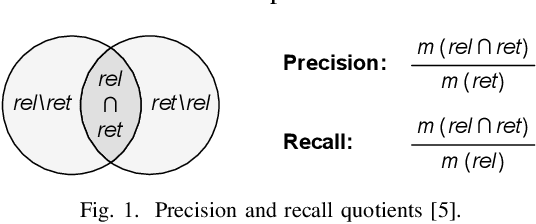
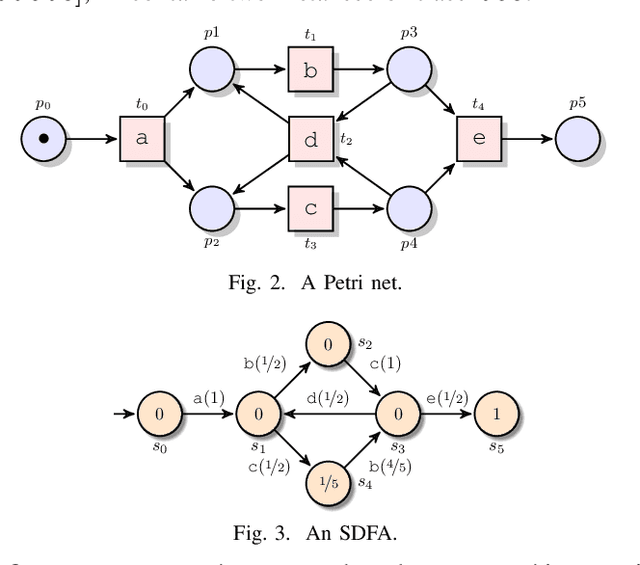

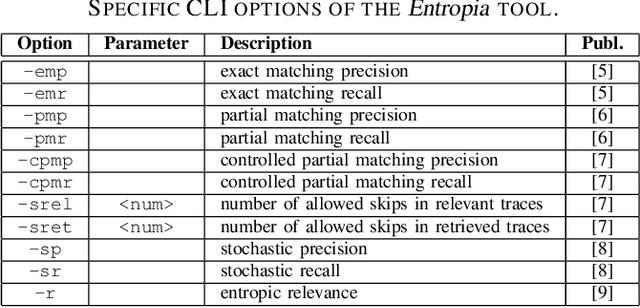
Abstract:This paper presents a command-line tool, called Entropia, that implements a family of conformance checking measures for process mining founded on the notion of entropy from information theory. The measures allow quantifying classical non-deterministic and stochastic precision and recall quality criteria for process models automatically discovered from traces executed by IT-systems and recorded in their event logs. A process model has "good" precision with respect to the log it was discovered from if it does not encode many traces that are not part of the log, and has "good" recall if it encodes most of the traces from the log. By definition, the measures possess useful properties and can often be computed quickly.
Comprehensive Process Drift Detection with Visual Analytics
Jul 15, 2019



Abstract:Recent research has introduced ideas from concept drift into process mining to enable the analysis of changes in business processes over time. This stream of research, however, has not yet addressed the challenges of drift categorization, drilling-down, and quantification. In this paper, we propose a novel technique for managing process drifts, called Visual Drift Detection (VDD), which fulfills these requirements. The technique starts by clustering declarative process constraints discovered from recorded logs of executed business processes based on their similarity and then applies change point detection on the identified clusters to detect drifts. VDD complements these features with detailed visualizations and explanations of drifts. Our evaluation, both on synthetic and real-world logs, demonstrates all the aforementioned capabilities of the technique.
 Add to Chrome
Add to Chrome Add to Firefox
Add to Firefox Add to Edge
Add to Edge